This is our second blog in a 3 part series highlighting the beautiful wildflower seeds that are in our Hill Country Pollinator Mix seed bags. In order to get the beautiful wildflowers you see in spring, you need to plant them in fall. There’s just no way around it. When it comes to wildflower planting, it’s definitely a “you snooze, you lose” type of situation.
We hope you enjoy our 2nd blog featuring more of what to expect from the seeds of some of our favorite wildflowers contained in our seed mix this year. Click the following links for: Part 1 , Part 3, Part 4, and for our bluebonnet blog.

8 Hill Country Wildflower Seeds for San Antonio, and the Hill Country inTexas
Common Milkweed (Asclepias syriaca)
This milkweed produces a huge, gorgeous flower from which many pollinators feast, but it is special to Monarch butterflies as a host and nectar plant. White/purple blooms throughout summertime. Needs plenty of sunshine, not tolerant of shade. These wildflowers typically grow about 3-5 feet tall, but can reach heights above that from time to time.
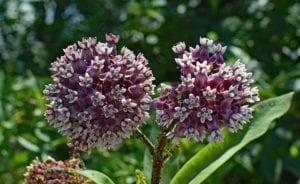
Corn Poppy (Papaver rhoeas)
These bright, red wildflowers are probably the ones that come to your mind when you hear the word poppy. Huge 2″-4″ fire-engine red blooms adorn slender stems from spring through summer. Well-drained soil is a must. Tolerant of sun to part sun. For a gorgeous “pop” of color, you can’t go wrong with Corn Poppies.
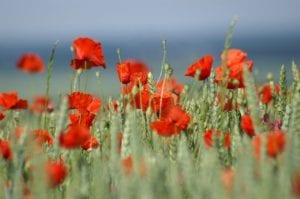
Cosmos (Cosmos sulphureus)
One of the taller species in the seed mix, growing to a mature height of 36″-48″, Sulphur Cosmos is an annual wildflower that produces blooms in brilliant colors of orange, red, and yellow. These brightly-hued flowers will attract butterflies, hummingbirds, and more. Plant in full to part sun, well-draining soil, and expect to see these abundantly self-seeding beauties from summer well into fall.
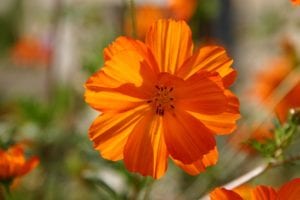
Drummond Phlox (Phlox Drummondii)
An annual wildflower that produces tight clusters of 5 petaled flowers in hues ranging from white, pink, rose, red, and lavender. This shorter wildflower generally grows to heights of 6″ – 12′ and attracts butterflies. Tolerant of part shade and dry soil. Blooms spring through summer months.

Englemann Daisy (Engelmannia peristenia)
Periods of drought don’t seem to bother the blooming procession of these sunny, yellow, perennial wildflowers. Flowers appear spring through early summer, and there is a cool possibility of another bloom period in fall if cut back late summer. (Just be sure to let seeds mature completely before mowing or collecting seeds.) Mature height of 1.5′ with evergreen foliage.
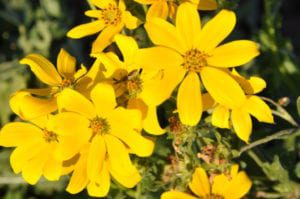
Gayfeather (Liatris spicata)
A perennial wildflower with vertical spikes of fluffy, showy blooms. Gayfeather or Liatris adds textural interest to wildflower meadows.Grows 2′-4′ tall and attracts multiple pollinators throughout its long blooming season mid summer through fall. Deer resistant and virtually pest and disease free.
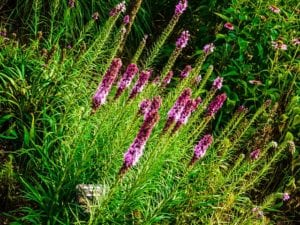
Grayhead Coneflower (Ratibida pinnata)
Long, lemon-yellow rays droop off of a grayish spherical cone center on these summer-blooming, perennial wildflowers. Growing to mature heights of 2′-4′, these coneflowers attract songbirds and butterflies. Not particular of soil type, this wildflower will grow in sun to part sun.

Greenthread (Thelesperma filifolium)
This wildflower totes a super long bloom period that runs from Ferbruary to December with the most profuse blooms being April through June. Butterflies and bees love the nectar, birds appreciate the seeds. Green thread gets its name for its super-fine thread-like foliage. Low water usage, full sun, semi-perennial.
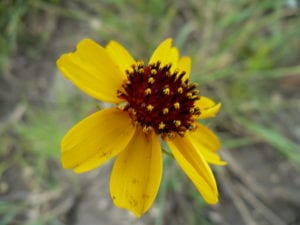
And there it is, the second installment of the next 8 ingredients in the Hill Country Pollinator Mix wildflower seed packages. If you missed Part 1 of the wildflower blog series you can access it at the link, followed by Part 3, and then Part 4. Close your eyes and imagine all of these flowers harmoniously mixed together in your landscape. Butterflies, bees, hummingbirds, and native birds swirling about drinking from the wildflower nectar. You’ve got yourself a little slice of heaven. Make sure to see our “Planting Wildflower in San Antonio” guide for successful growing tips.
Gotta end it with another amazing wildflower quote, this time from the unequivocal Tom Petty: “You belong among the wildflowers. You belong in a boat out at sea. You belong with your love on your arm. You belong somewhere you feel free.”
~ The Happy Gardener, Lisa Mulroy

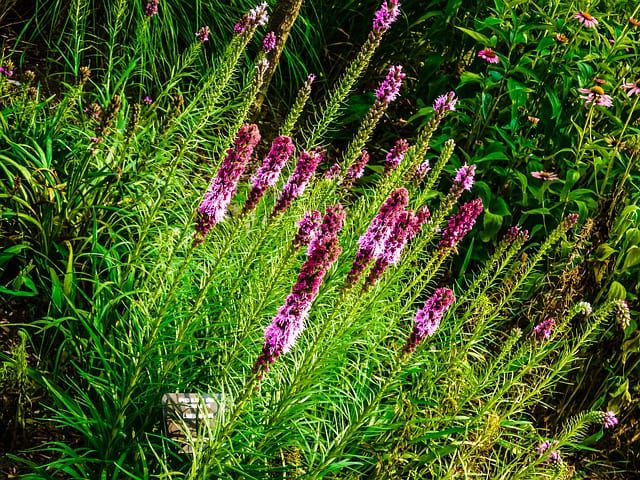
I need information for planting wildflowers for this spring—Hayes county, hill country Thank you Ted Cleaves
Hi Ted,
Sorry I am just seeing this. I am attaching our Wildflower planting guide for you. You should start planting those seeds asap. Soil contact is a huge factor to success. Wildflower Planting Guide